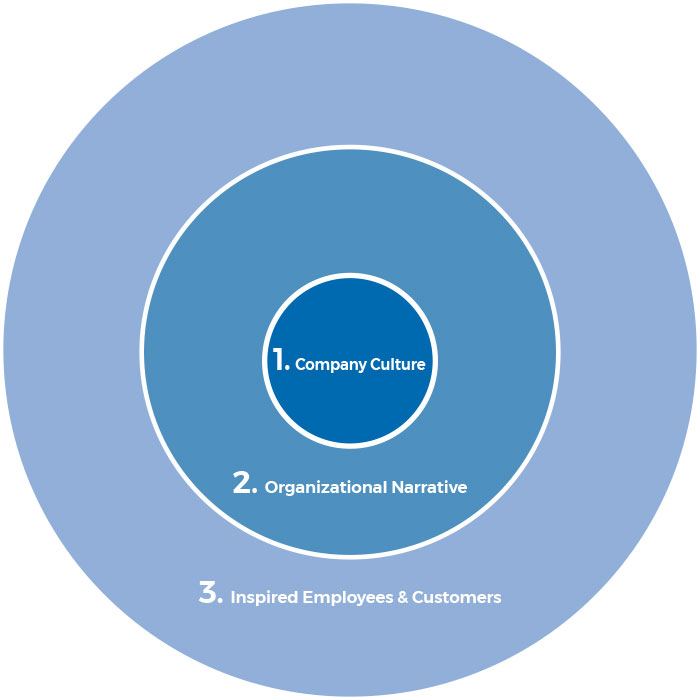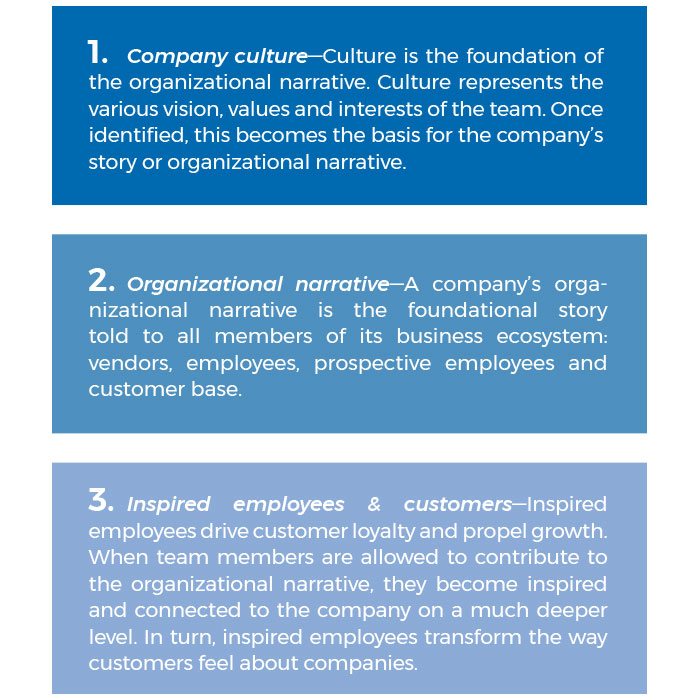Culture is the living value system of an organization. It is also the organizational narrative you create and live by, and the story you tell your employees and customers. Nurturing your company’s culture is critically important to moving the company forward.
But how do you move the concept of culture from an owner’s vision, through the mind of an inspired employee, and into the hands of your clients? What can you do as a leader to ensure mission statements become more than veiled sentiments or posters in the lunchroom? How do you use them to become the fuel that drives employees, engages customers and propels growth?
The following questions will explore growth through the lens of the construction industry; how various corporate cultures reflect value systems; how different companies view their employees’ roles in shaping culture; and why creating an inspired team is necessary to develop a positive culture.
1. What are some challenges of defining company culture?
Regardless of the approach, it’s hard to argue against the importance of culture as it relates to growth, employee engagement, employee retention and profitability. But has the construction industry fully embraced its potential?
Recent research shows a clear interest among business owners to develop cultures that engage their teams and increase the bottom line. However, the nuances found within this industry present unique challenges that must be considered when designing a company culture.
Trae Lamborne, chief executive officer (CEO) at Egress Solutions, a specialty contractor in Tabernacle, New Jersey, points out some of these challenges: “The socioeconomic, cultural and intellectual diversity of employees, teams and organizational structures within our industry presents unique challenges to creating a unified culture for construction companies,” Lamborne said. “For example, the personal and professional goals of a laborer may be vastly different from those of an administrative employee, manager or leader. His/her goal may be to simply be treated well, have a steady income, and provide for his/her family. Being an active part of an organizational culture is less likely to be important to him/her.”
This issue presents a real challenge in the industry’s efforts to use company culture as a mechanism for cohesiveness and growth, particularly as it relates to employee retention in an ever-present and increasing skilled labor shortage.
“It is imperative our industry embraces the utilization of culture as a mechanism for sustainability and growth” said Chris Stone, vice president of Hyde-Stone Mechanical Contractors in Watertown, New York. “It is becoming increasingly difficult to find and retain good employees. Whether it’s office or field staff, future leaders or managers—as owners and leaders, it is our responsibility to build a culture that attracts and represents the needs, interests and future of all our team members.”
Garnering authentic employee engagement and maintaining the culture you develop are two critical approaches to sustaining a positive culture.
Although involving every employee in designing and maintaining corporate culture isn’t always possible, it is important to allow for input, recognize the interests and needs (beyond leadership) of the entire team, and incorporate those voices into the organization.
2. What does cultural maintenance look like?
Chief Operating Officer (COO) Jamie Porterfield and President Dennis Pruitt of Waldrop Inc., a specialty contractor located in Greenville, South Carolina, understand the importance of both employee engagement and cultural maintenance. “We work on culture every day. Our underlying principles are to treat people fairly, care for our team, inspire our team to care for others and ensure that we treat everyone in our business ecosystem like family—including our customers,” said Porterfield.
According to Pruitt, “The most important thing to note is that the maintenance of your culture cannot be done in weekly meetings or monthly get-togethers. The maintenance of your culture is a minute-by-minute affair and must be reflected in every decision you make and every action you take. It is only through this approach that it can be woven into the DNA of past, current and future generations of team members, leaders and customers alike.”


3. How do I build authentic employee engagement?
Nothing can compete with a team that is cohesive, and nothing brings people together more than everyone on the team feeling valued. “After many years in the construction business, I have determined that there are two great motivators of human beings: love and loyalty. Clearly, you will not always love everyone you work with, but there can always be loyalty. And loyalty it is a two-way street. Building real equity with your employees by having a sincere interest in them and their families will build loyalty and inspire people to give their best,” said Pruitt.
“As leaders, our responsibility is not only to ensure our teams feel valued, but also to ensure they understand the role they play within the company and its future. The more educated an employee is as it relates to the company, the more they feel valued and want to advance in their career to be part of something bigger than themselves.”
Living by the golden rule and educating team members on their roles and value to the company are two important approaches to maintaining a positive culture.
A third, which is perhaps an extension of understanding employee needs, is introducing a sense of freedom to team members that transcends both the workplace and their responsibilities at home.
“We give our employees freedom to make decisions and have input into possible changes within the company, particularly when it comes to areas that impact their work. This provides them with sense of connectivity, voice and buy-in,” said Pruitt.
“In addition, long ago we introduced the philosophy and credo of ‘Go.’ When my kids were younger, I coached lacrosse and rarely missed a play, musical or game, and that made me enjoy my work more. I was not a slave to it at the cost of my family life. We now have employees in the same situation, and if they need to ‘Go,’ we encourage it,” Pruitt said.
4. How do I design a sustainable culture?
There are many different approaches to designing an organizational culture, and sometimes—though not often—corporate cultures emerge naturally. The first of two popular approaches to this is the “top-down” approach.
In a recent article from Inc. Magazine, author Peter Cohan describes the creation of corporate culture as “a set of values that leaders use to shape how people think and act.” He continues, “Leaders create culture by choosing an organization’s values, publicly acting in ways that make those values clear to others and using the values to hire, promote and fire people.” In this top-down approach, owners and/or leaders determine what values best represent the organization’s current or future state and construct a company culture around those values. They use them to shape hiring practices, engage their community and drive employee engagement.
The second approach is the “bottom-up” approach, or a team approach. Perhaps the best example of the bottom-up approach is the strategy Whole Foods Market Inc. (WFM) used to create its culture, and ultimately, differentiate itself in what, at the time, was an “industry characterized by negligible growth rates and declining profits,” as described in Unique Work Culture and Practices: A Case Study.
After struggling to differentiate itself in a crowded marketplace, WFM managed to pull away from its competition in early 2005 by employing a team-centric approach to creating culture. “Teams were the focal point of operations, and they formed the core of the company’s culture. The entire system was divided into teams, even up to the highest level in the hierarchy,” according to the study.
This approach is usually dictated by the size and structure of the organization. The top-down approach is frequently adopted by larger firms, while small to midsize companies seem far more eager to adopt an all-inclusive strategy. In either approach, culture must be seen as a culmination of the wants, needs, value systems and interests of all employee segments and teams.
5. What do I do if my culture is misaligned?
In construction’s ever-evolving environment, it isn’t uncommon for an organization’s culture to lose traction or become misaligned. Shifts in the marketplace—including labor, technology and generational shifts—are forcing companies to revisit, and often redesign, their corporate culture.
To combat both internal and external shifts in environment, you might consider revisiting the culture (and its purpose) by engaging in one or more of the following:
- Schedule an off-site meeting—Having a facilitated, off-site meeting to revisit your company’s mission, core values, culture and organizational narrative (what story you are telling your stakeholders) is always a good idea. Getting your leadership team and others away from the office and looking at the company through a variety of different lenses will challenge your view, help you envision a different future, and lay the foundation for an adjusted culture.
- Benchmarking through surveys—There are several individual and group personality assessments to help you and your team assess how your employees feel about their work and the organization’s culture. Try the Golden Personality Type Profiler, which explores an individual’s strengths, as well as their ability to work with a team.
- Creating a culture committee—Every company has that group of employees who are willing to go the extra mile. Once you have identified this group in your organization, empower them to help the leadership team redesign current strutures, policies, procedures, etc. to achieve the company culture you desire.
Ultimately, culture doesn’t reside solely within the vision of the founder, owner or leadership team. It is in the collective voice of everyone that makes the engine turn, and it should be the driving force for growth and a top priority for every business owner. In the end, it’s what keeps employees—and customers—coming back.
